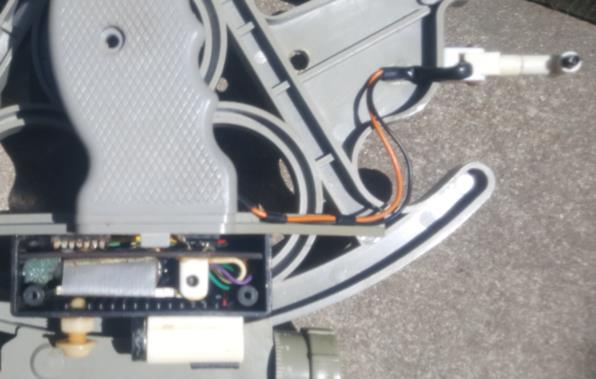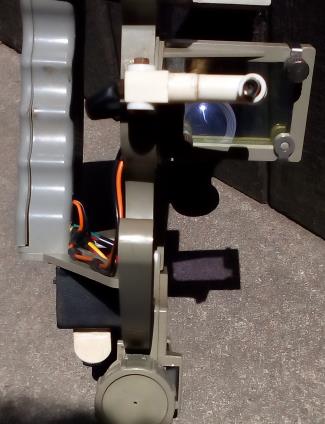
NavList:
A Community Devoted to the Preservation and Practice of Celestial Navigation and Other Methods of Traditional Wayfinding
Re: New ways to create false horizons?
From: Pete Solon Palmer
Date: 2017 Jul 18, 20:05 -0400

From: Pete Solon Palmer
Date: 2017 Jul 18, 20:05 -0400
I made an artificial horizon for my Davis sextant. Just for laughs & giggles, I'll share it here.

It has 3 major parts: the black box (LL), articulated light boom (UR), and battery compartment (UL).
The black box is an electronics project box cut in half and glued to the sextant. In the center of the box, covered by the duct tape is a 2-way Mercury switch mounted on a swing platform. On the lower left of the box is a nylon adjusting screw to fine tune the angle of the Mercury switch. In the upper left of the box is a flip-flop chip so that the light is on when the Mercury switch is off. On the lower right of the box is a slide switch and potentiometer for on/off/brightness control.
On the right of the photo is the light boom. This came from an "Itty-Bitty Book Light" as did the slide switch and potentiometer . The book light was a white LED, so I replaced that with a red LED. To deploy this boom, just swing it 90 degrees so that it is squarely in front of the Horizon mirror.
The batteries go in the handle. I used 4, AAA pen-lite cells wired in series to give about 5 or 6 volts, which is suitable for the chip and the LED.
Under sail. it was completely useless due to the motion, but if becalmed in glassy water, in the fog, it was better than nothing. The problem was that the Mercury switch was too sensitive. I drilled a hole in the glass tube and tried water, diesel, and silicon spray lubricant as a dampener, but still too sensitive. I didn't have any mineral oil.
I'm thinkin' it might work better with a home-made level switch. One idea that comes to mind is to make the switch from a piece of flexible tube with a ball bearing in it and 2 contacts near the bottom. The tube could be slightly curved with the curvature controlled by the nylon adjusting screw to decrease the sensitivity. I realize that the accuracy will go down when the sensitivity is adjusted down, but there might be a sweet spot in there, somewhere.
Regards,
Pete
Pete
-----Original Message-----
From: Jan Jaap Maes <NoReply_JanJaapMaes@fer3.com>
To: globenav <globenav@aol.com>
Sent: Tue, Jul 18, 2017 8:30 am
Subject: [NavList] New ways to create false horizons?
From: Jan Jaap Maes <NoReply_JanJaapMaes@fer3.com>
To: globenav <globenav@aol.com>
Sent: Tue, Jul 18, 2017 8:30 am
Subject: [NavList] New ways to create false horizons?
Dear all that have a passion for astronavigation,
I have written my master dissertation on false horizons at the AMA Belgium - celestaire PBH and davis artificial horizon - and I would like to know how many of you astronavigators have used or bought an instrument like this to train before you go out at sea on merchant vessels, pleasure yachts, uscoastguard, etc or even the professional version that is being made by C&P?
The goal of my dissertation was to show my academy that it is indeed possible with a false horizon to teach future officers to train with a sextant in practice and determine ones position when there is no horizon available in the form of the natural seahorizon. I had good results and was able to pinpoint the location of where I was standing to within <1' with the use of a celestaire PBH. Unfortunately there were some setbacks:
PBH was not 100% compatible with my C&P sextant
The davis artificial horizon was not suited to be used for culmination of the sun
...
Who of you has already bought these items or does anyone know how much are being sold worldwide to estimate how many people train with these before they go out to sea
This is :
Practice bubble horizon -PBH- from celestaire
Artificial horizon from Davis
professional bubble horizons from C&P
Are there companies out there that are working on improving these instruments being these companies or others because I see a lot of patents when searching with google patents , but most of them are from inventors from the United States Navy.
Like finding a way to eliminate the bubble correction with the pro bubble and PBH?
combining a bubble with a nightscope or whatever?
The big reason to ask this is because I am passionate about the topic and I want to help stop sending officers onboard that just read the gps coordinates without knowing the background of how GPS works.
Let me know something and good star hunting!
Best regards,
MSc Jan Jaap Maes








